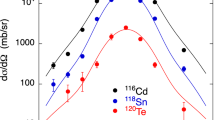Abstract
Experimental data on the cross sections for channels of fusion and transfer reactions induced by beams of radioactive halo nuclei and clustered and stable loosely bound nuclei were analyzed, and the results of this analysis were summarized. The interplay of the excitation of single-particle states in reaction-product nuclei and direct reaction channels was established for transfer reactions. Respective experiments were performed in stable (6Li) and radioactive (6Не) beams of the DRIBs accelerator complex at the Flerov Laboratory of Nuclear Reactions, Joint Institute for Nuclear Research, and in deuteron and 3Не beams of the U-120M cyclotron at the Nuclear Physics Institute, Academy Sciences of Czech Republic (Řež and Prague, Czech Republic). Data on subbarrier and near-barrier fusion reactions involving clustered and loosely bound light nuclei (6Li and 3He) can be described quite reliably within simple evaporation models with allowance for different reaction Q-values and couple channels. In reactions involving halo nuclei, their structure manifests itself most strongly in the region of energies below the Coulomb barrier. Neutron transfer occurs with a high probability in the interactions of all loosely bound nuclei with light and heavy stable nuclei at positive Q-values. The cross sections for such reactions and the respective isomeric ratios differ drastically for nucleon stripping and nucleon pickup mechanisms. This is due to the difference in the population probabilities for excited single-particle states.
Similar content being viewed by others
References
G. Audi and A. H. Wapstra, Nucl. Phys. A 595, 409 (1995).
G. Audi et al., Nucl. Phys. A 729, 337 (2003).
Yu. E. Penionzhkevich et al., Eur. Phys. J. A 31, 185 (2007).
Yu. E. Penionzhkevich et al., J. Phys. G 36, 025104 (2009).
N. K. Skobelev, N. A. Demekhina, R. Kalpakchieva, et al., Phys. Part. Nucl. Lett. 6, 208 (2009).
N. K. Skobelev, A. A. Kulko, V. Kroha, et al., J. Phys. G 38, 035106 (2011).
A. A. Kulko, N. K. Skobelev, V. Kroha, V. Burjan, Z. Hons, A. V. Daniel, N. A. Demekhina, R. Kalpakchieva, A. Kugler, J. Mrázek, Yu. E. Penionzhkevich, Š. Piskoř, Yu. G. Sobolev, and E. Simevckova, Bull. Russ. Acad. Sci.: Phys. 75, 538 (2011).
N. K. Skobelev, A. A. Kulko, Yu. E. Penionzhkevich, E. I. Voskoboinik, V. Kroha, V. Burjan, Z. Hons, J. Mrazek, S. Piskovr, and E. Simevckova, Phys. Part. Nucl. Lett. 10, 410 (2013).
N. K. Skobelev, Yu. E. Penionzhkevich, A. A. Kulko, N. A. Demekhina, V. Kroha, A. Kugler, S. M. Lukyanov, J. Mrázek, Yu. G. Sobolev, V. A. Maslov, Yu. A. Muzychka, E. I. Voskoboynik, and A. S. Fomichev, Bull. Russ. Acad. Sci.: Phys. 77, 360 (2013).
S. Y. F. Chu, L. P. Ekström, and R. B. Firestone, The Lund/LBNL Nuclear Data, Search Version (1999). http://nucleardata.nuclear.lu.se/nucleardata/toi/
S. M. Lukyanov et al., J. Phys. G 41, 035102 (2014).
N. K. Skobelev, Phys. At. Nucl. 77, 1415 (2014).
L. Meyer-Schytzmeister et al., Nucl. Phys. A 199, 593 (1973).
R. W. Barnand and G. D. Jones, Nucl. Phys. A 111, 17 (1968).
N. Anyas-Weiss et al., Phys. Rep. 12, 201 (1974).
W. R. McMurray et al., Nucl. Phys. A 265, 517 (1976).
R. A. Broglia and A. Winther, Heavy Ion Reactions, Lecture Notes (AddisonWesley, Redwood City, USA, 1991), Vol. 1, p. 349.
P. J. A. Buttle and L. J. B. Goldfarb, Nucl. Phys. A 176, 299 (1971).
N. K. Skobelev, Phys. At. Nucl. 78, 652 (2015).
M. N. Rao, J. Rapaport, T. A. Belote, and W. E. Dorenbusch, Nucl. Phys. A 151, 351 (1970).
V. V. Samarin and K. V. Samarin, Bull. Russ. Acad. Sci.: Phys. 76, 450 (2012).
V. V. Samarin, in Proceedings of the 7th International Symposium on Exotic Nuclei EXON 2014, Kaliningrad, Russia, Sept. 8–13, 2014 (JINR, Dubna, 2014), p. 30.
A. A. Kulko, N. A. Demekhina, R. Kalpakchieva, et al., J. Phys. G 34, 2297 (2007).
D. E. DiGregorio, K. T. Lesko, B. A. Harmon, et al., Phys. Rev. C 42, 2108 (1990).
S. A. Karamian, J. J. Carroll, N. V. Aksenov, et al., Nucl. Instrum. Methods Phys. Res. A646, 87 (2011).
Y. Nagame et al., Phys. Rev. C 41, 889 (1990).
N. Chakravarty, P. K. Sarkar, and S. Ghosh, Phys. Rev. C 45, 1171 (1992).
V. R. Casella, Report LA-5830-T (Los Alamos Scientific Laboratory, 1975).
A. Lemasson, A. Navin, and M. Rejmund, Phys. Lett. B 697, 454 (2011).
A. Shrivastava, A. Navin, and A. Lemasson, Phys. Rev. Lett. 103, 232702 (2009).
Author information
Authors and Affiliations
Corresponding author
Additional information
Original Russian Text © N.K. Skobelev, 2016, published in Yadernaya Fizika, 2016, Vol. 79, No. 4, pp. 347–355.
Rights and permissions
About this article
Cite this article
Skobelev, N.K. Effect of nuclear-reaction mechanisms on the population of excited nuclear states and isomeric ratios. Phys. Atom. Nuclei 79, 534–542 (2016). https://doi.org/10.1134/S1063778816040207
Received:
Published:
Issue Date:
DOI: https://doi.org/10.1134/S1063778816040207



